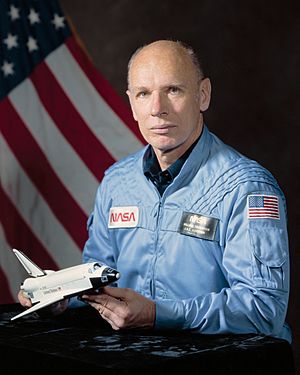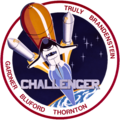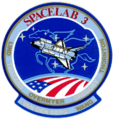William E. Thornton facts for kids
Quick facts for kids
William E. Thornton
|
|
|---|---|

Thornton in 1981
|
|
| Born |
William Edgar Thornton
April 14, 1929 Faison, North Carolina, U.S.
|
| Died | January 11, 2021 (aged 91) Fair Oaks Ranch, Texas U.S.
|
| Nationality | American |
| Alma mater | University of North Carolina, B.S. 1952, M.D. 1963 |
| Occupation | Medical Doctor |
| Space career | |
| NASA Astronaut | |
|
Time in space
|
13d 01h 16m |
| Selection | 1967 NASA Group 6 |
| Missions | STS-8, STS-51-B |
|
Mission insignia
|
|
| Retirement | May 31, 1994 |
William Edgar Thornton (born April 14, 1929 – died January 11, 2021) was an American NASA astronaut and a medical doctor. He earned degrees in physics and medicine from the University of North Carolina. Dr. Thornton flew into space twice aboard the Space Shuttle Challenger. His missions were STS-8 and STS-51-B. He was known for his research on how the human body adapts to space.
Contents
Early Life and Education
William Edgar Thornton was born on April 14, 1929. He grew up and went to school in Faison, North Carolina. In 1952, he earned a bachelor's degree in physics from the University of North Carolina (UNC). Later, in 1963, he received his medical degree from UNC.
Becoming an Astronaut and Doctor
After college, Thornton joined the Air Force. He worked in an instrumentation lab, helping with flight tests. From 1956 to 1959, he was a chief engineer in Los Angeles. He led a team that worked on aircraft electronics.
In 1959, he went back to medical school at UNC. After becoming a doctor in 1963, he completed his internship. He then returned to the United States Air Force. He trained as a flight surgeon, a doctor who specializes in the health of pilots and astronauts.
During this time, Dr. Thornton became very interested in space medicine. He applied to NASA and was chosen to become an astronaut. He also invented the first devices that could measure mass (weight) in space. These devices are still used today. Thornton also spent over 2,500 hours flying jet aircraft.
NASA Career and Space Medicine Research
In August 1967, William Thornton was selected as a scientist-astronaut by NASA. He completed his flight training in Texas. He was a doctor on the Skylab Medical Experiments Altitude Test (SMEAT). This was a 56-day test on Earth that simulated a Skylab mission. It helped scientists learn how astronauts' bodies would react in space.
Dr. Thornton was also part of the support team for the Skylab 2, 3, and 4 missions. He studied how astronauts' bodies changed in space. He looked at things like body fluid shifts and how muscles got weaker. He was the first to document these changes.
He helped develop new ways for astronauts to work in space. He also studied how the body moves in space. For the Space Shuttle program, he continued his research on the heart, muscles, and nervous system. He designed the treadmill used for exercise in space. He strongly believed that exercise was important to prevent problems like bone loss in space. His work helped understand how astronauts adapt to space.
Thornton held over 60 patents. These included inventions for military systems and medical devices. His space-related inventions included devices to measure mass in space. He also designed systems to protect against shock and vibration. He improved waste collection and other equipment for astronauts.
He continued his work in space medicine, focusing on longer space missions. He designed exercise equipment for the Space Shuttle and future space stations. This equipment included improved treadmills, rowing machines, and bicycles. Much of his work is still used in space today.
Space Missions
Dr. Thornton flew on two Space Shuttle missions.
STS-8: First Night Launch
STS-8 was the third flight of the Space Shuttle Challenger. It launched on August 30, 1983, and landed on September 5, 1983. This mission was special because it was the first time a Space Shuttle launched and landed at night. Dr. Thornton was one of five crew members.
During this flight, he continuously studied how the human body adapted to being in weightlessness. He focused on the nervous system and how astronauts adjust to space. Much of the equipment he used was designed by him. The mission orbited Earth 98 times. At 54 years old, Dr. Thornton became the oldest person to fly in space at that time.
STS-51B: Spacelab-3 Mission
STS-51B was also flown on the Space Shuttle Challenger. It launched on April 29, 1985, and landed on May 6, 1985. This mission carried the Spacelab-3 science module.
During this 7-day flight, Dr. Thornton was in charge of the first animal payload on a Space Shuttle mission. He also conducted other medical studies. The mission orbited Earth 110 times. After this flight, Dr. Thornton had spent over 313 hours in space.
After NASA
William Thornton retired from NASA on May 31, 1994. After his astronaut career, he taught at the University of Texas Medical Branch in Galveston, Texas. He also taught at the University of Houston–Clear Lake. In 2010, he donated his NASA papers and records to the North Carolina State Archives.
Awards and Honors
Dr. Thornton received many awards for his important work:
- Air Force Legion of Merit (1956)
- NASA Exceptional Service Medal (1972)
- NASA Exceptional Scientific Achievement Medal (1974)
- American Astronautical Society's Melbourne W. Boynton Award (1977)
- Two NASA Space Flight Medals (1983, 1985)
- University of North Carolina Distinguished Alumni Award (1983)
- Aerospace Medical Association Randy Lovelace Award (1984)
- AIAA Jeffries Medical Research Award (1985)
- Association of Military Surgeons of the United States Kern Award (1986)
- NASA Exceptional Engineering Achievement Medal (1988)
Personal Life
William Thornton was married to Elizabeth Jennifer Fowler. They had two sons. He passed away at his home in Fair Oaks Ranch, Texas, on January 11, 2021, at the age of 91.
Images for kids
See also
 In Spanish: William Thornton (astronauta) para niños
In Spanish: William Thornton (astronauta) para niños




